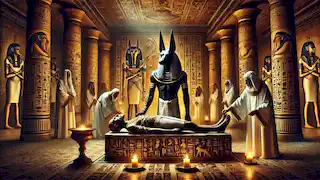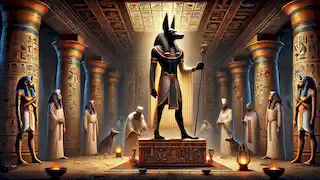In the vast and ancient kingdom of Egypt, where the Nile stretched its life-giving waters through the desert, the gods and goddesses governed every aspect of existence. They were worshipped, feared, and honored as both creators and protectors, and among them, none stood more solemn and mysterious than Anubis, the jackal-headed god of death and mummification. Anubis, the great protector of souls, was not merely a deity of darkness; he represented the balance between life and death, justice and chaos, the cycle of renewal that defined the ancient Egyptian belief in the afterlife.
Anubis’s presence was ubiquitous in Egyptian tombs, temples, and funerary rites. His sacred duty was to ensure the safety and purity of the deceased as they ventured into the unknown realms of the afterlife, where they would face judgment before Osiris, the lord of the dead. But Anubis’s story begins much earlier, entwined with the myths of Egypt’s most powerful gods and goddesses and their eternal struggle for balance in the cosmos. Anubis's tale begins with his mother, Nephthys, and the tumultuous relationship she shared with her husband, Set. Nephthys was the sister of Isis, the goddess of magic and motherhood, and she was married to Set, the god of chaos, storms, and destruction. However, the marriage between Nephthys and Set was fraught with tension, for Set was often consumed by his lust for power and his rivalry with Osiris, the ruler of Egypt and the god of the afterlife. In a moment of weakness and betrayal, Nephthys sought solace in the arms of Osiris, her sister’s husband, and from their union was born Anubis. Fearing Set’s wrath and knowing that her son’s birth was the product of infidelity, Nephthys abandoned Anubis in the wilderness, hoping to shield him from the inevitable violence that would ensue if Set discovered the truth. It was Isis who found the infant Anubis. Moved by compassion, she took him in and raised him as her own child. Under her care, Anubis grew into a wise and dutiful god, learning the sacred rites of mummification and the mysteries of death from the goddess herself. He developed a profound understanding of the passage between life and death, a role that would define his existence in the Egyptian pantheon. Despite his tumultuous beginnings, Anubis became a god of immense power and responsibility. He was the guardian of the dead, the overseer of mummification, and the guide who led souls through the perilous journey to the afterlife. He was tasked with protecting the dead from evil forces and ensuring that they received the proper rites and rituals necessary to secure their place in the Field of Reeds, the Egyptian paradise. To the ancient Egyptians, death was not the end of life, but the beginning of a new journey into the afterlife. However, to reach the afterlife, one’s body had to be preserved through the sacred process of mummification, a process overseen by Anubis. It was believed that only by preserving the body could the soul find its way to the afterlife and achieve eternal peace. Anubis’s role in mummification began with the legendary story of Osiris’s death. Set, driven by jealousy and hatred, devised a cunning plan to murder his brother Osiris and take his throne. He invited Osiris to a banquet and tricked him into lying in a beautifully crafted coffin. As soon as Osiris was inside, Set sealed the coffin shut and cast it into the Nile, where it drifted away and was lost to the waters. Set’s treachery did not end there. After recovering Osiris’s body from the river, Set dismembered it into fourteen pieces and scattered them across the land, ensuring that his brother could never return to life. Isis, heartbroken by the loss of her husband, embarked on a desperate search to find the pieces of Osiris’s body. She enlisted the help of Anubis, whose knowledge of death and the afterlife was unparalleled. Together, Isis and Anubis traveled the length and breadth of Egypt, collecting the scattered remains of Osiris. Anubis carefully embalmed the body, wrapping each piece in linen and using his sacred rituals to purify the corpse. It was said that Anubis invented the process of mummification during this act, laying the foundation for the rites that would be performed for all the dead in Egypt. Anubis’s skill in preserving Osiris’s body allowed Isis to use her magic to bring her husband back to life. Though Osiris could no longer rule the land of the living, he was reborn as the lord of the underworld, ruling over the dead with wisdom and compassion. Anubis, having proven his loyalty and mastery over death, was entrusted with the sacred duty of overseeing all funerary practices and ensuring that the souls of the dead were properly prepared for their journey. Priests who served Anubis during funerals wore masks that depicted his jackal face, believing that they channeled his divine power as they performed the mummification process. The embalming rituals were long and complex, requiring the removal of internal organs, the purification of the body with natron salts, and the careful wrapping of the corpse in linen. Anubis watched over these ceremonies, ensuring that they were conducted with the utmost reverence and precision. Anubis’s duties did not end with mummification. Once a person’s body had been properly preserved, their soul faced the most critical part of their journey: the Weighing of the Heart ceremony. This ceremony determined whether the soul was worthy of entering the afterlife or doomed to eternal oblivion. The ancient Egyptians believed that the heart was the seat of a person’s soul, emotions, and morality. When a person died, their heart was weighed against the feather of Ma’at, the goddess of truth and justice. If the heart was lighter than the feather, the soul was deemed pure and allowed to pass into the Field of Reeds, where they would enjoy eternal happiness. However, if the heart was heavier than the feather, weighed down by evil deeds and guilt, the soul would be devoured by Ammit, a fearsome creature with the head of a crocodile, the body of a lion, and the hindquarters of a hippopotamus. Anubis was the one who presided over this solemn ritual. As the god of judgment and protector of souls, he placed the heart on the scales and oversaw the proceedings. He stood alongside Thoth, the god of wisdom and writing, who recorded the outcome of the weighing. If the heart was found to be pure, Anubis guided the soul safely into the afterlife, where they were welcomed by Osiris and allowed to live in peace for all eternity. Despite the gravity of his role, Anubis was not a merciless judge. He was known to be compassionate and understanding, offering guidance to souls who were uncertain or afraid. His jackal-headed form, though intimidating, was a symbol of protection, ensuring that the deceased were not abandoned to the chaos of the underworld but were given a fair chance to prove their worth. Throughout his existence, Anubis played a pivotal role in the eternal battle between order and chaos, a central theme in Egyptian mythology. As the protector of the dead, Anubis stood in opposition to the forces of disorder and destruction, represented by his father, Set. This conflict was embodied in the myth of Osiris, in which Anubis sided with Isis and Horus against Set’s destructive influence. The battle between Osiris and Set symbolized the struggle for control over Egypt and the balance of the cosmos. Set’s murder of Osiris and his attempt to seize the throne represented the triumph of chaos and disorder, while Osiris’s resurrection and his subsequent rule over the underworld symbolized the restoration of order and justice. Anubis, by aiding in the preservation of Osiris’s body and overseeing the judgment of souls, ensured that the forces of order prevailed. This duality of chaos and order was reflected in the very nature of Anubis himself. Though he was the god of death, a domain often associated with fear and uncertainty, Anubis represented the promise of renewal and the hope for eternal life. His role was not to sow fear but to provide guidance and protection, ensuring that the dead could pass safely through the trials of the afterlife and achieve their rightful place in paradise. In the physical world, Anubis’s presence was also seen as a guardian of tombs and cemeteries. Jackals, animals that roamed the desert and scavenged near burial sites, were feared as desecrators of graves. However, the ancient Egyptians believed that Anubis, in his jackal form, protected the dead from harm, preventing their bodies from being disturbed and ensuring that they remained at peace. Anubis was one of the most recognizable deities in ancient Egyptian art and iconography. He was most commonly depicted as a man with the head of a black jackal, though sometimes he appeared entirely as a jackal. His black coloration was symbolic of both death and resurrection, representing the fertile black soil of the Nile, which allowed life to flourish even after death. In many depictions, Anubis was shown holding a flail or a staff, symbols of his authority over the dead. He often appeared in tombs and on sarcophagi, standing watch over the deceased as they journeyed to the afterlife. His image was also present in the funerary texts, such as the Book of the Dead, where he guided souls through the perilous underworld and assisted in the Weighing of the Heart ceremony. Amulets bearing the likeness of Anubis were commonly worn by both the living and the dead, as they were believed to provide protection from evil spirits and ensure a safe passage to the afterlife. These amulets were often placed within the wrappings of mummies or worn by the priests who conducted the mummification process. The presence of Anubis’s image was a constant reminder of his role as the eternal guardian of souls, watching over the dead with vigilance and care. Though the civilization that worshipped Anubis has long since faded, the god’s legacy remains strong in modern culture. Anubis has come to symbolize death, judgment, and the mysteries of the afterlife, transcending his original role in Egyptian religion to become a universal figure of protection and guidance. His jackal-headed form is instantly recognizable in art, literature, and film, where he is often portrayed as a guardian of the dead or a guide to the afterlife. In modern interpretations, Anubis is often depicted as a fearsome figure, representing the darker aspects of death and the unknown. However, to the ancient Egyptians, he was a compassionate protector, a god who ensured that the dead were treated with dignity and that their souls were given a fair chance to reach the afterlife. Anubis’s association with death was not one of fear but of respect, as he represented the hope for resurrection and eternal peace. The myths and legends surrounding Anubis continue to captivate the imagination of people around the world. His story is a reminder of the ancient Egyptians’ deep belief in the afterlife and their understanding of death as a transition rather than an end. Through Anubis, we see the importance of balance, justice, and the eternal cycle of life and death, themes that resonate across cultures and throughout history.The Secret Origins of Anubis
The Sacred Rites of Mummification

Anubis’s Role as the Judge of Souls

Anubis and the Battle Between Order and Chaos

The Iconography of Anubis in Ancient Egypt

Anubis’s Enduring Legacy



















